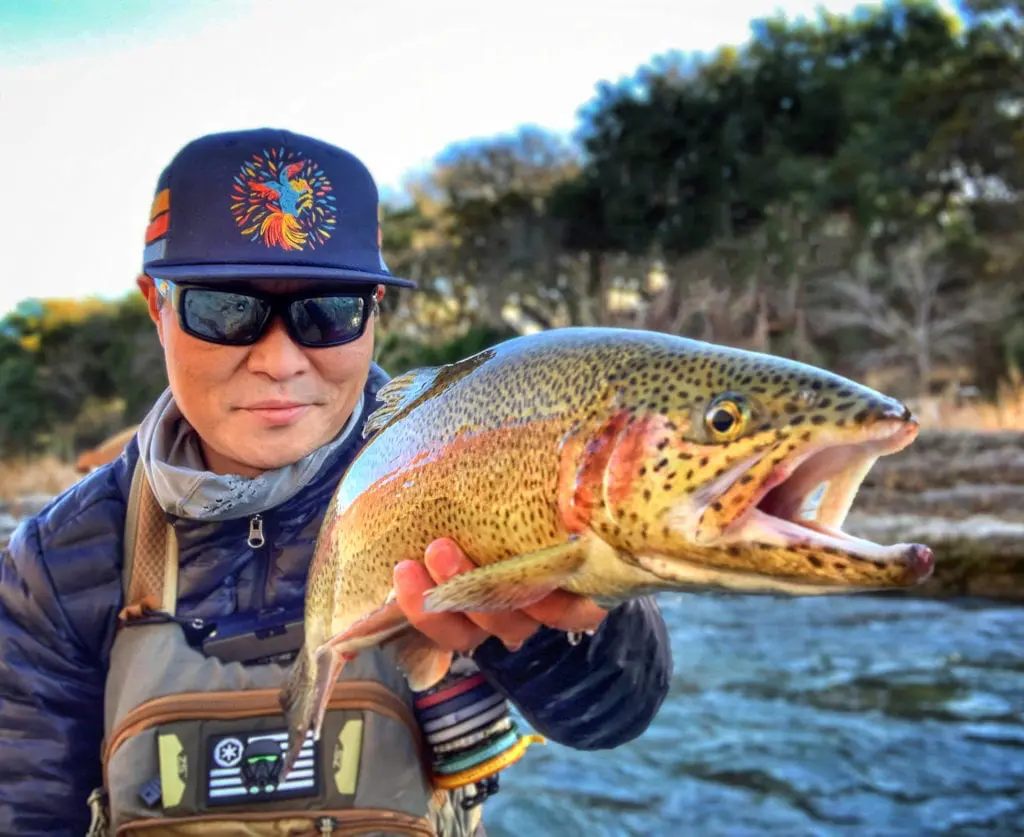By Nate Skinner, for Lone Star Outdoor News
It’s trout season on the Guadalupe River, and that’s no secret to the angling population. Crowds of fly-fishermen are flocking to the stream to try their hand at catch- ing rainbows on the fly. Weekdays are less crowded than the weekends; however, the immense fishing pressure has educated the fish. Those able to make their hand-tied offerings drift through the water naturally are experiencing the most hookups.
Another obstacle anglers are having to overcome is the low rate of flow. The aver- age flow of the river is typically anywhere from 100-300 cfs. The Guadalupe is currently flowing at about 80 cfs. With the water low and moving slowly, the fish are concentrating in tighter areas.
Nymph fly patterns have been the ticket for coaxing strikes from trout, and anglers using two different types of strategies have been the most successful. These techniques include indictor nymphing and using a nymph without a strike indicator.
San Antonio resident Odom Wu prefers not to use a strike indicator while fly-fishing the Guad. Instead, he uses homemade flies he has tied himself, weighted with tungsten beads.

“I like to fly-fish for rainbows on the Guadalupe using a Euro-nymphing approach,” he explained. “Instead of fishing with an indicator floating on the surface to show me when a fish strikes my fly as it is drifting with the current, I use weight- ed flies and a highly visible multi-colored line.”
Wu said this approach allows him to better control the depth at which his fly is being swept through the water column.
“I use my rod and the variations of color on my line to manage the depth of my fly,” he said. “This helps me to stay in constant contact with my fly and catch more fish. I also feel like the fly has a much more natural appearance without the drag of an indicator as it is drifting through the current.”
Wu has landed several 18-20 inch trout using this technique, and said the fish seem to be more aggressive in areas with faster moving water.
Fly-fishing guide Davin Topel said the best fishing for trout is occurring from the Maricopa Riverside Lodge down to the fourth crossing.
“Just about anywhere that there is cur- rent and moving water on this stretch of the river is holding plenty of fish,” Topel said. “The key is keeping the fly along the bottom — your fly has to be bumping the bottom in order to get bit. If you are using an indicator, it should be bouncing along the surface, due to your fly sweeping across the river bottom.”
Topel’s customers have been catching rainbows anywhere from 10-21 inches around deeper drop-offs and shelfs.
“High sticking and tight line nymphing has been producing some excellent fish and more bites it seems,” said guide Nate Wilson.
Wilson recently had a client land a 22- inch rainbow and said he’s seen a lot of fish in the 18-20 inch range being caught by seasoned fly anglers.
“The more natural of a presentation that you can give your fly, the more likely you are to catch bigger fish,” he said. “Older, larger fish are harder to fool due to the amount of pressure the river gets, but if you can make your fly look real, they are going to eat it.”
Guide John Shank has been targeting limestone channels and ledges to catch plenty of trout.
“Smaller fly patterns fished under an indicator have been producing the best results for my clients,” he said. “The best approach is to use flies that mimic the most recent hatch on the river.”
On a good day, Shank said anglers are landing about 30 percent of the fish that strike.
“These rainbows can be finicky, and the evidence of strong fishing pressure is definitely noticeable,” he said.
In addition to rainbows, Shank said good-sized striped bass are also lurking in the Guad.
“These fish are not easy to catch, and a lot of the larger ones eat small trout,” he said. “I target them by using large, 8- to 10-inch streamers that mimic a small rain- bow.”
Shank recently had a customer land a 28-inch, 13-pound striper on the Guadalupe during a day of trout fishing.


